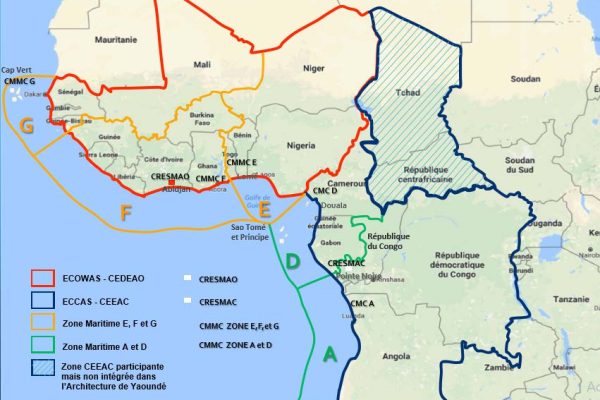English | Français | Português

June 2023 marked the 10th anniversary of the Code of Conduct Concerning the Prevention and Repression of Piracy, Armed Robbery against Ships, and Illicit Maritime Activities in West and Central Africa (Yaoundé Code of Conduct). Signed in Yaoundé, Cameroon by representatives of 25 West and Central African governments, the Code of Conduct created a zonal security architecture stretching from Senegal to Angola. The intent was that signatory member states –who were members of two different Regional Economic Communities (RECs), the Economic Community of West African States (ECOWAS) and the Economic Community of Central African States (ECCAS)—would share a common operating picture of the threats and challenges in the Gulf of Guinea maritime domain and, importantly, would respond collectively to those threats unimpeded by seams between the RECs and states’ sovereign territorial waters.
The Yaoundé Code of Conduct was one of several maritime security protocols that emerged in Africa in the first two decades of the 21st century, in a milieu of enhanced focus, by both African states and international partners, on the maritime domain after a surge in piracy off the Horn of Africa in the mid-2000s. The Yaoundé Code of Conduct came on the heels of a regional maritime security strategy adopted by ECCAS in 2008, a 2009 regional maritime code of conduct for East Africa (the Djibouti Code of Conduct), a maritime strategy adopted by the Southern African Development Community (SADC) in 2011, and a continent-wide maritime strategy adopted by the African Union (AU) in 2012. An important feature of the 2013 Yaoundé Code of Conduct was that it widened the aperture of security beyond piracy (the focus of the Djibouti Code of Conduct) to an array of challenges including armed robberies and illegal, unreported, and unregulated fishing (an expanded focus also taken by the AU’s strategy).
Africa Center alumni and faculty played a key role in the emergence and then operationalization of the 2013 Yaoundé Code of Conduct. When one ECCAS member state was confronting rising criminality in the waters off its coast by nationals of an ECOWAS member state, it reached out to the United States for advice. When consulted, the Africa Center proposed that this should not be treated as a bilateral issue between two countries, but as an opportunity for the two RECs to dialogue. Thus began a series of meetings and consultations which resulted in the Yaoundé Code of Conduct and then continued past its adoption to bring about the operationalization of key elements of the protocol. Dr. Assis Malaquias, the Academic Dean of the Africa Center, recalls that a “hard nucleus” of alumni took ownership of the negotiations, including, among others, Rear Admiral (ret.) Adeniyi Adejimi (Jimi) Osinowo from Nigeria; Rear Admiral Oumar Wade from Senegal, now National Security Advisor to the President of Senegal; Dr. Ali Kamal-Deen from Ghana, now Executive Director of the Center for Maritime Law and Security in Africa; Dr. Abdourahmane Dieng, now head of ECOWAS’ Regional Security Division; CAPT Charles Bamele from Cote d’Ivoire, now the Operational Coordination Director of the Ivorian Inter-ministerial Committee for State Action at Sea; and Mr. Abroulaye Fofana from Cote d’Ivoire, now the Permanent Secretary of the Ivorian Inter-ministerial Committee for State Action at Sea.
Ten years after the adoption of the Yaoundé Code of Conduct, many have been reflecting on its accomplishments and the work that remains to be done, including African officials, academics, international partners, the UN Peacebuilding Commission, the AU Peace and Security Council, the UN Security Council, and the Africa Center’s Dean. According to Dr. Malaquias, the success and longevity of the Yaoundé architecture was not a foregone conclusion. There were numerous challenges (e.g. linguistic, political), barriers related to different types of training and equipment, and questions about whether African states would resource the architecture.
Today, however, the architecture not only exists, but it’s become a model for how to do maritime cooperation at the regional level. Countries of the Gulf of Guinea work together to address their common challenges and there is a “culture of collaboration.” The creation of trust among participants is the code of conduct’s greatest accomplishment. Another important lesson is that a small, motivated community of practitioners can have an impact.
Despite these successes, the job of pooling sovereignty and building capacity to confront maritime security challenges in the Gulf of Guinea is not done. The Yaoundé architecture works, but not optimally or equally across all of the zones. Full interoperability has not been achieved and issues of coordination and information sharing still exist. At the national level, not all signatories have created national maritime strategies or national maritime authorities or resourced them adequately. If the ultimate goal is to have a multilayered, cascading series of maritime strategies stretching from the continental level to the regional level to the sub-regional level to the national level, work remains to be done. This remains a rich area for Africa Center alumni and faculty to make a contribution.

